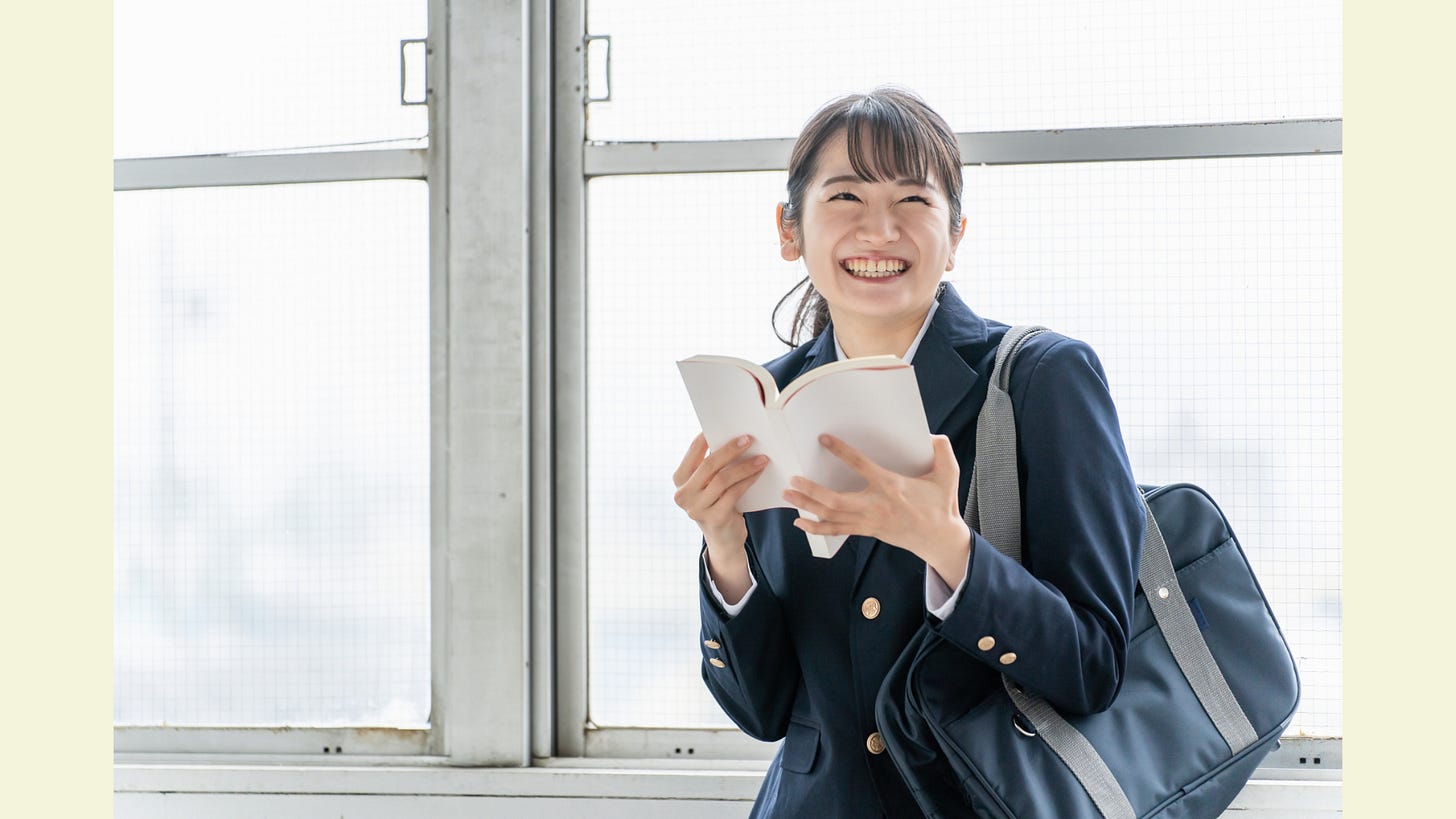Education System in Japan
日本(にほん)の きょういくシステム

1. 就学前教育(しゅうがくまえ きょういく)
Pre-school Education
日本(にほん)では、小学校(しょうがっこう)の 前(まえ)に、子(こ)どもが 行(い)く ところが あります。
In Japan, children go to preschool before entering elementary school.
幼稚園(ようちえん)は、3歳(さんさい)〜6歳(ろくさい)の 子(こ)どもが 行(い)きます。
Kindergartens are for children aged 3 to 6.
→ 約(やく)95%の 子(こ)どもが 幼稚園(ようちえん)か 保育園(ほいくえん)に 行(い)きます。
→ About 95% of children go to either kindergarten or nursery school.
保育園(ほいくえん)は、0歳(ぜろさい)〜6歳(ろくさい)の 子(こ)どもが 行(い)きます。
Nursery schools are for children aged 0 to 6.
認定子ども園(にんてい こどもえん)は、幼稚園(ようちえん)と 保育園(ほいくえん)が いっしょに なった 所(ところ)です。
Certified “kodomo-en” combine both kindergarten and nursery school in one place.
2. 小学校(しょうがっこう)【6年間(ねんかん)】
Elementary School (6 years
6歳(ろくさい)〜12歳(じゅうにさい)の 子(こ)どもが 小学校(しょうがっこう)に 行(い)きます。
Children aged 6 to 12 go to elementary school.
→ 100%の 子(こ)どもが 小学校(しょうがっこう)に 入(はい)ります(義務教育(ぎむきょういく)です)。
→ 100% of children enter elementary school. (It is compulsory education.)
国語(こくご)、算数(さんすう)、理科(りか)、社会(しゃかい)、図工(ずこう)、音楽(おんがく)、体育(たいいく)などを 勉強(べんきょう)します。
They learn Japanese, math, science, social studies, art, music, physical education, and more.
3. 中学校(ちゅうがっこう)【3年間(ねんかん)】
Junior High School (3 years)
12歳(じゅうにさい)〜15歳(じゅうごさい)の 生徒(せいと)が 行(い)きます。
Students aged 12 to 15 go to junior high school.
→ ほぼ 100%の 生徒(せいと)が 中学校(ちゅうがっこう)に 進学(しんがく)します。
→ Almost 100% of students move on to junior high school.
英語(えいご)、数学(すうがく)、理科(りか)、社会(しゃかい)、国語(こくご)、技術・家庭(ぎじゅつ・かてい)、美術(びじゅつ)、体育(たいいく)などを 勉強(べんきょう)します。
They study English, math, science, social studies, Japanese, technology and home economics, art, and P.E.
義務教育(ぎむ きょういく)
Compulsory Education
日本(にほん)では、小学校(しょうがっこう)と 中学校(ちゅうがっこう)の 9年間(きゅうねんかん)が 義務教育(ぎむ きょういく)です。
In Japan, elementary school and junior high school (9 years total) are compulsory education.
4. 高校(こうこう)【3年間(ねんかん)】
High School (3 years)
15歳(じゅうごさい)〜18歳(じゅうはっさい)の 生徒(せいと)が 行(い)きます。
Students aged 15 to 18 attend high school.
→ 約(やく)98%の 生徒(せいと)が 高校(こうこう)に 進学(しんがく)します。
→ About 98% of students go on to high school.
高校(こうこう)には、普通科(ふつうか)と 専門科(せんもんか)が あります。
High schools have general courses and vocational courses.
たとえば、商業(しょうぎょう)、工業(こうぎょう)、農業(のうぎょう)、看護(かんご)、外国語(がいこくご)などが あります。
For example: business, technology, agriculture, nursing, or foreign languages.
5. 高等教育(こうとう きょういく)
Higher Education
高校(こうこう)を 出(で)た あと、大学(だいがく)や 専門学校(せんもんがっこう)に 行(い)く ことが できます。
After high school, students can go to college or vocational school.
→ 約(やく)83%の 人(ひと)が 高等教育(こうとう きょういく)を うけます。
→ About 83% of people go on to higher education.
大学(だいがく)【4年間(ねんかん)】
University (4 years)
ふつうの 大学(だいがく)は 4年(ねん)ですが、いがく などは 6年(ねん)です。
Most universities are 4 years, but medicine and some others are 6 years.
大学(だいがく)を そつぎょうすると、学士(がくし)という 学位(がくい)を もらえます。
When they graduate, they receive a degree called “Gakushi” (Bachelor’s degree).
短期大学(たんき だいがく)【2〜3年間(ねんかん)】
Junior College (2–3 years)
短大(たんだい)では、保育(ほいく)や 看護(かんご)などを 学(まな)びます。
At junior colleges, students study things like childcare or nursing.
専門学校(せんもん がっこう)【2〜4年間(ねんかん)】
Vocational School (2–4 years)
しごとに つかえる 技術(ぎじゅつ)や 資格(しかく)を 学(まな)ぶ ところです。
Vocational schools teach skills and licenses useful for work.
たとえば:料理(りょうり)、アニメ、まんが、コンピューターなど。
For example: cooking, animation, manga, or computers.

